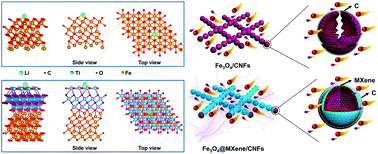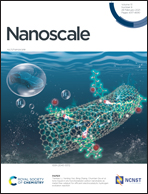MXene-encapsulated hollow Fe3O4 nanochains embedded in N-doped carbon nanofibers with dual electronic pathways as flexible anodes for high-performance Li-ion batteries†
Abstract
Fe3O4 is one of the promising anode materials in Li-ion batteries and a potential alternative to graphite due to the high specific capacity, natural abundance, environmental benignity, non-flammability, and better safety. Nevertheless, the sluggish intrinsic reaction kinetics and huge volume variation severely limit the reversible capacity and cycling life. In order to overcome these hurdles and enhance the cycling life of Fe3O4, a one-dimensional (1D) nanochain structure composed of 2D Ti3C2-encapsulated hollow Fe3O4 nanospheres homogeneously embedded in N-doped carbon nanofibers (Fe3O4@MXene/CNFs) is designed and demonstrated as a high-performance anode in Li-ion batteries. The distinctive 1D nanochain structure not only inherits the high electrochemical activity of Fe3O4, but also exhibits excellent electron and ion conductivity. The Ti3C2 layer on the Fe3O4 hollow nanospheres forms the primary electron transport pathway and the N-doped carbon nanofiber network provides the secondary transport pathway. At the same time, Ti3C2 flakes partially accommodate the large volume change of Fe3O4 during Li+ insertion/extraction. Density functional theory (DFT) calculations demonstrate that the Fe3O4@MXene/CNFs electrode can efficiently enhance the adsorption of Li+ to promote Li+ storage. As a result of the electrospinning process, self-restacking of Ti3C2 flakes and aggregation of Fe3O4 nanospheres can be prevented resulting in a larger surface area and more accessible active sites on the flexible anode. The Fe3O4@MXene/CNFs anode has remarkable electrochemical properties at high current densities. For example, a reversible capacity of 806 mA h g−1 can be achieved at 2 A g−1 even after 500 cycles, corresponding to an area specific capacity of 1.612 mA h cm−2 at 4 mA cm−2 and a capacity as high as 613 mA h g−1 is retained at 5 A g−1, corresponding to an area capacity of 1.226 mA h cm−2 at 10 mA cm−2. The results indicate that the Fe3O4@MXene/CNFs anode has excellent properties for Li-ion storage.



 Please wait while we load your content...
Please wait while we load your content...